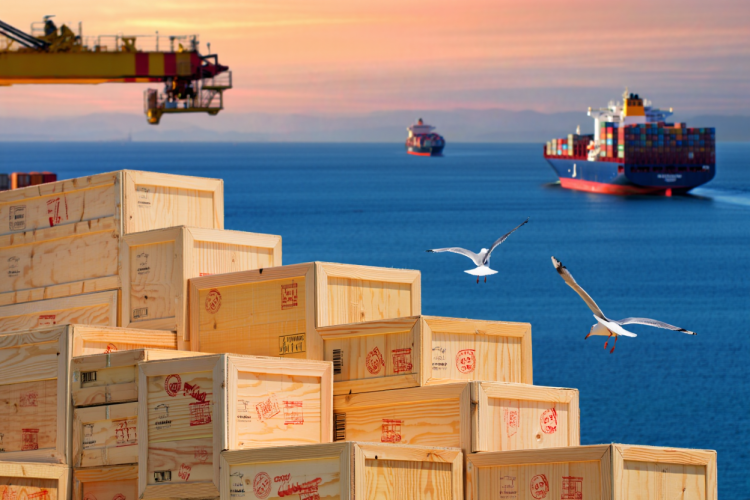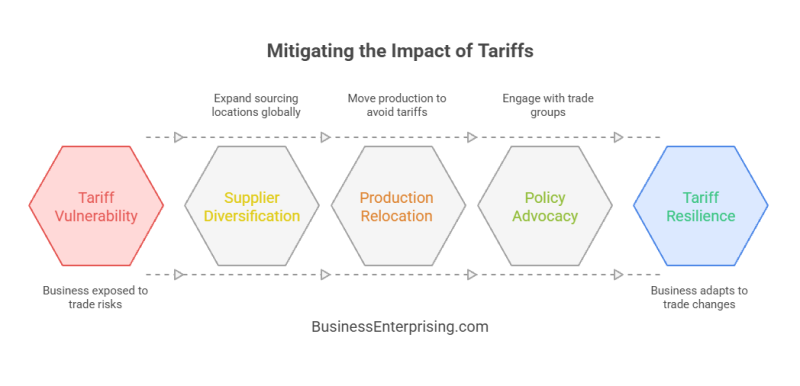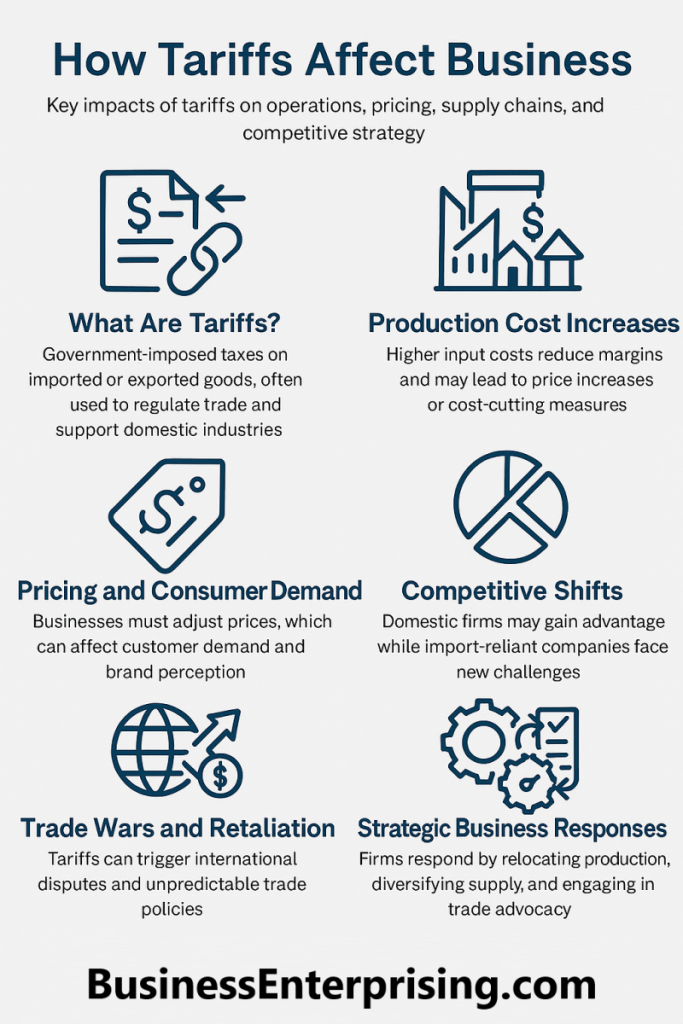 Tariffs affect more than pricing. They can reshape how you source, produce, and compete. Understanding how tariffs affect business helps you make informed decisions. These taxes influence your supply chain, your costs, and even your customer relationships. You may not always see the impact right away, but it can build quickly.
Tariffs affect more than pricing. They can reshape how you source, produce, and compete. Understanding how tariffs affect business helps you make informed decisions. These taxes influence your supply chain, your costs, and even your customer relationships. You may not always see the impact right away, but it can build quickly.
Additionally, tariffs can shift depending on political or economic goals. Because of this, your long-term plans may need constant review. You might depend on imports that become more expensive with little notice. Therefore, you must stay ready to adjust when rules change or new tariffs appear.
Many companies respond by changing their suppliers or moving production. Others work with trade groups to voice concerns. These strategies aim to reduce disruption and protect profit margins. However, each path comes with trade-offs that you must weigh carefully.
Understanding the risk helps you protect your business. Therefore, you should take time to assess where tariffs affect your operations. If you import goods or materials, this is even more important. Knowing your exposure helps you respond quickly and avoid major surprises.
Additionally, tariffs can create new opportunities for some businesses. Domestic producers may gain a pricing advantage when imports become costly. Because of that, you should also review your competitive position. A change in trade policy could help or hurt, depending on your setup. By knowing the basics and watching the trends, you give yourself an edge. Planning ahead lets you adapt with less stress and fewer delays.
Understanding Tariffs: Definition and Types
Tariffs are taxes governments place on goods that cross their borders. These taxes apply when products are imported or exported. Most often, countries use tariffs on imports to protect local industries and raise revenue. You may see higher prices on foreign goods due to these taxes.
Import duties are the most common form of tariff. They apply when goods enter a country. Export duties, on the other hand, are much less common. Some countries still use them to manage the flow of resources or maintain domestic supply. Your business may face both types depending on what you ship and where.
There are two main types of tariffs. The first is an ad valorem tariff. This means the tax is based on a percentage of the product’s value. For example, if a good is worth $1,000 and the tariff is 10%, the importer pays $100 in tax. The second is a specific tariff. This applies a fixed amount per unit, like $5 per ton or $3 per item. Each type influences pricing and strategy differently.
Understanding how tariffs affect business can help you plan more effectively. Tariffs can shape your sourcing choices and shift production decisions. Additionally, they may impact your pricing structure or force you to renegotiate supplier contracts. For companies trading internationally, tariffs add a layer of cost and complexity.
Therefore, you should monitor tariff policies regularly. Trade agreements can change and introduce new duties with little notice. Because of this, it’s smart to stay ready for adjustments. You don’t need to become a trade expert, but knowing the basics helps. That way, your business can stay responsive and avoid surprises.
Impact on Supply Chains and Production Costs
Tariffs can directly impact your supply chain and increase your production costs. When a tariff applies to imported goods, raw material prices often rise. If you rely on parts or inputs from abroad, your expenses go up fast. That change affects your pricing, margins, and overall profitability.
Additionally, many businesses need to adjust their suppliers when tariffs hit. This process takes time and often adds delays. You might find yourself juggling new vendors, shipping routes, or schedules. Each adjustment costs money and disrupts daily operations. These small disruptions can build into bigger issues that slow down output.
Therefore, you may need to reassess your contracts or payment terms. Suppliers affected by tariffs may pass costs to you. That pressure squeezes your margins and reduces pricing flexibility. Because of this, some companies absorb the costs while others raise their prices. Either option can affect your competitive position.
Tariffs can also lead to inventory shifts. You may try to stock up before duties take effect. However, that ties up capital and storage space. If you work in manufacturing or wholesale, these changes may force you to rethink your strategy. Over time, even small tariffs can have a big impact on your supply chain.
Understanding how tariffs affect business helps you plan better. Knowing which parts of your supply chain face risk lets you respond quickly. You can find new sources, adjust your forecasts, or renegotiate terms. With the right planning, you stay ahead of problems instead of reacting to them. That makes your operation more stable and less exposed to sudden changes.
Pricing Strategies and Consumer Demand
When tariffs increase your costs, you often need to rethink how you price your products. Higher input costs usually lead to higher prices. That shift can affect how customers view your value. They may buy less or switch to lower-cost options.
Therefore, many companies adjust their pricing strategies to absorb or pass on added expenses. You might raise prices slowly or only on select items. This helps reduce the shock for your customers. However, some buyers still react strongly to price increases. That makes demand less stable and harder to predict.
Additionally, price sensitivity varies by product type. If your item is a basic need, demand may hold steady. But for luxury or non-essential goods, sales may drop quickly. Because of this, pricing strategy becomes more important during tariff changes. You need to know how much customers will tolerate before they walk away.
Tariffs also affect your competition. If your rivals find cheaper suppliers, they may keep prices lower. That puts pressure on you to respond. You might need to offer promotions, reduce package sizes, or shift to lower-margin items. These moves can protect market share but reduce profit per sale.
Understanding how tariffs affect business helps you avoid pricing mistakes. You need to balance costs, demand, and customer expectations. Therefore, tracking customer behavior is key. If you know how they react to price changes, you can plan smarter. Over time, a strong pricing strategy helps protect your bottom line, even in uncertain trade conditions.
Competitive Advantage and Market Positioning
Tariffs can shift the way your business competes in the market. If you depend on foreign inputs, you may lose pricing power. Domestic producers, however, may gain an edge. Their costs stay lower if they rely less on imports. This changes the balance between local and international competitors.
Therefore, companies with shorter supply chains may benefit. They can hold prices steady or offer better delivery timelines. You, on the other hand, may need to rework your sourcing model. This creates pressure to become more efficient or change product lines. Additionally, higher input costs may push you out of certain price points.
Because of these shifts, market positioning becomes more sensitive. Your brand might be known for affordability, but that may change quickly. Tariffs can force a new pricing tier or alter how customers see your value. Therefore, you need to monitor how competitors respond and where you still fit.
Additionally, tariffs can influence brand loyalty. Some customers may favor local products if they believe tariffs support domestic industries. Others may see price hikes as unfair, even when you’re not to blame. You must plan for both reactions and stay clear in your messaging.
Understanding how tariffs affect business helps you adjust more confidently. You may need to reposition your products, revise marketing strategies, or change suppliers. These actions take time but can protect your market share. Over time, companies that stay flexible gain a stronger advantage, even in unstable trade environments.
Tariff Retaliation and Global Trade Risks
Tariffs rarely happen in isolation. When one country raises import taxes, another may respond with its own set of tariffs. This back-and-forth can lead to trade wars. These disputes grow quickly and impact businesses that depend on foreign customers or suppliers. If your business exports goods, your pricing may become less competitive overnight.
Additionally, trade retaliation often targets key industries. Governments aim for impact, which means your sector could be next. Because of this, you may face sudden shifts in costs or demand. You may also see partners pause deals or delay shipments. These risks make long-term planning harder.
Therefore, geopolitical shifts can disrupt more than supply chains. They can change market access, currency values, and contract terms. Even small tariffs can create waves. You might need to rethink where you sell and where you source. Some companies even exit certain markets to avoid the risk.
Understanding how tariffs affect business means knowing the broader risk. A single policy change can lead to worldwide consequences. Trade rules evolve with political changes, not always economic logic. That uncertainty adds pressure on your forecasts and investment decisions. You must stay informed and act quickly when new rules take effect.
Because of these risks, many businesses now build flexibility into their plans. You may consider diversifying your supply base or selling in more markets. These choices help reduce exposure to future trade conflicts. While no plan is perfect, some preparation makes your business more resilient in the face of global shifts.
Strategic Responses: Relocation, Diversification, and Lobbying
When tariffs increase your costs, you may need to rethink where and how you operate. Some companies relocate production to avoid added expenses. This shift helps them maintain pricing and protect margins. However, moving operations takes time and involves upfront investment. You need to weigh that cost against long-term savings.
Additionally, many businesses start sourcing from different countries. If one trade route becomes too expensive, another may offer better terms. This flexibility helps reduce future exposure to tariffs. Therefore, building a more diverse supply base gives you more options when trade rules shift. You gain stability by not depending on a single region.
Because tariffs also involve government action, some companies turn to policy advocacy. Industry groups may push for exemptions or temporary relief. If tariffs directly affect your product, speaking out may help. You can work with trade associations or legal teams to make your case. This effort takes time, but it may reduce your exposure.
Understanding how tariffs affect business leads to better planning. You may not control policy, but you can control your response. With the right mix of relocation, diversification, and advocacy, you stay agile. These steps can make a meaningful difference when new tariffs take effect.
Therefore, you should monitor global trade developments closely. Don’t wait until problems show up in your margins. Review your suppliers, production locations, and government contacts regularly. Planning ahead gives you more control, even in unstable conditions.
Conclusion
Tariffs continue to shape how companies operate, plan, and compete. You may not feel the effects right away, but they build. Therefore, understanding trade policies helps you prepare for shifts that affect your pricing, supply chain, or customers.
Additionally, your response to tariffs can protect your position. You might consider new suppliers, adjust production, or revise your pricing. These moves can support long-term stability. Because global trade conditions change often, flexibility gives you an advantage. Acting early reduces your risk and helps avoid rushed decisions.
Therefore, you should review your supply sources and cost structures regularly. Tariffs can change the value of your current partnerships. You may benefit from renegotiating or diversifying. Monitoring the trade environment gives you more time to adjust when policies shift.
Understanding how tariffs affect business is not about predicting every event. It’s about recognizing where your business is vulnerable. You don’t need perfect foresight. You need a plan that works under pressure. That starts with being informed and responsive.
Additionally, your team should stay connected to global developments. A small change in one country may ripple through your entire operation. By watching those changes closely, you make better decisions faster.
Therefore, treat tariffs as part of your regular planning process. Doing so helps protect your profits and avoid disruption. With the right awareness and a few smart moves, your business can stay steady no matter how the trade winds shift.



